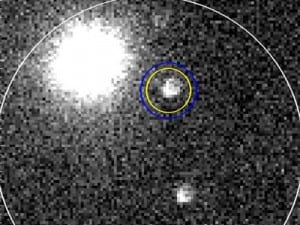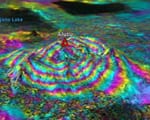“You’re looking at things a long time ago in the universe, you can get a sense for the movie of the universe,” said Kehoe. “It’s the evolution of the universe.”
The Texas newspaper the Houston Chronicle covered the astronomy research of physicist Robert Kehoe, SMU professor, and two graduate students in the SMU Department of Physics, Farley Ferrante and Govinda Dhungana.
The astronomy team in May reported observation of intense light from the enormous explosion of a star more than 12 billion years ago — shortly after the Big Bang — that recently reached Earth and was visible in the sky.
Known as a gamma-ray burst, light from the rare, high-energy explosion traveled for 12.1 billion years before it was detected and observed by a telescope, ROTSE-IIIb, owned by SMU.
Gamma-ray bursts are believed to be the catastrophic collapse of a star at the end of its life. SMU physicists report that their telescope was the first on the ground to observe the burst and to capture an image.
Recorded as GRB 140419A by NASA’s Gamma-ray Coordinates Network, the burst was spotted at 11 p.m. April 19 by SMU’s robotic telescope at the McDonald Observatory in the Davis Mountains of West Texas.
Houston Chronicle reporter Heather Alexander reported the news in his article “Texas scientists spot 12-billion-year old star explosion.”
EXCERPT:
By Heather Alexander
Houston ChronicleTexas scientists have spotted a massive explosion in space that dates back 12 billion years, almost to the time of the Big Bang, according to Southern Methodist University in Dallas.
NASA satellites recorded the burst and signalled back to the McDonald Observatory in West Texas. Telescope pictures showed a gamma ray burst, believed to be the collapse of a star.
“Gamma-ray bursts are the most powerful explosions in the universe since the Big Bang,” said graduate student Farley Ferrante, who was monitoring the telescope. “These bursts release more energy in 10 seconds than our Earth’s sun during its entire expected lifespan of 10 billion years.”
The scientists said explosions like this are key to understanding the development of the universe.
“Twelve billion years ago, it was a very different universe,” said Robert Kehoe, physics professor and leader of the SMU astronomy team. “It was just hydrogen and helium. There were no rocks, there was no matter; our solar system had not formed.”
Kehoe says explosions like the one shown in the photo are stars exploding, scattering new elements like carbon, oxygen, silicon and iron into the surrounding area.
Follow SMUResearch.com on Twitter.
For more information, www.smuresearch.com.
SMU is a nationally ranked private university in Dallas founded 100 years ago. Today, SMU enrolls nearly 11,000 students who benefit from the academic opportunities and international reach of seven degree-granting schools. For more information see www.smu.edu.
SMU has an uplink facility located on campus for live TV, radio, or online interviews. To speak with an SMU expert or book an SMU guest in the studio, call SMU News & Communications at 214-768-7650.


 Low IQ students learn to read at 1st-grade level after persistent, intensive instruction
Low IQ students learn to read at 1st-grade level after persistent, intensive instruction Richest marine reptile fossil bed along Africa’s South Atlantic coast is dated at 71.5 mya
Richest marine reptile fossil bed along Africa’s South Atlantic coast is dated at 71.5 mya Satellite view of volcanoes finds the link between ground deformation and eruption
Satellite view of volcanoes finds the link between ground deformation and eruption